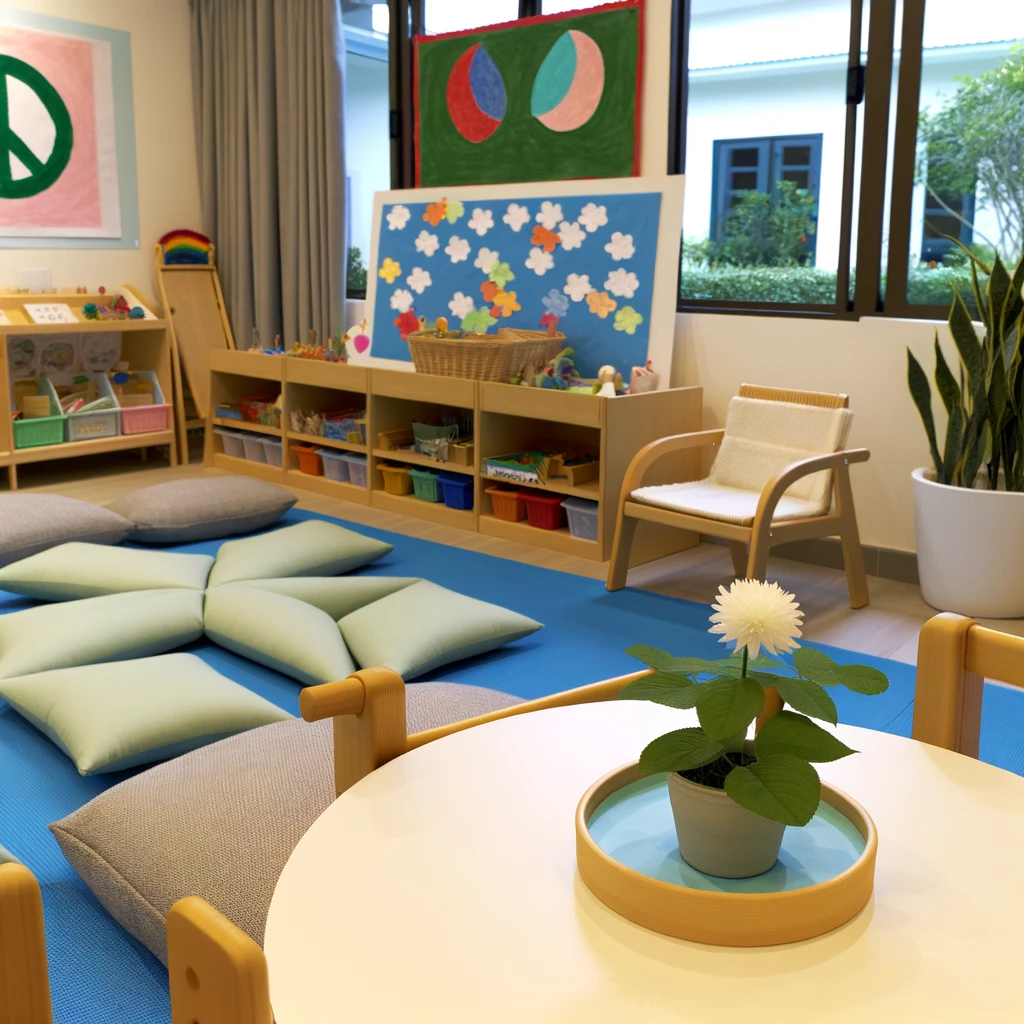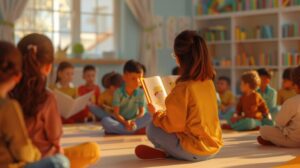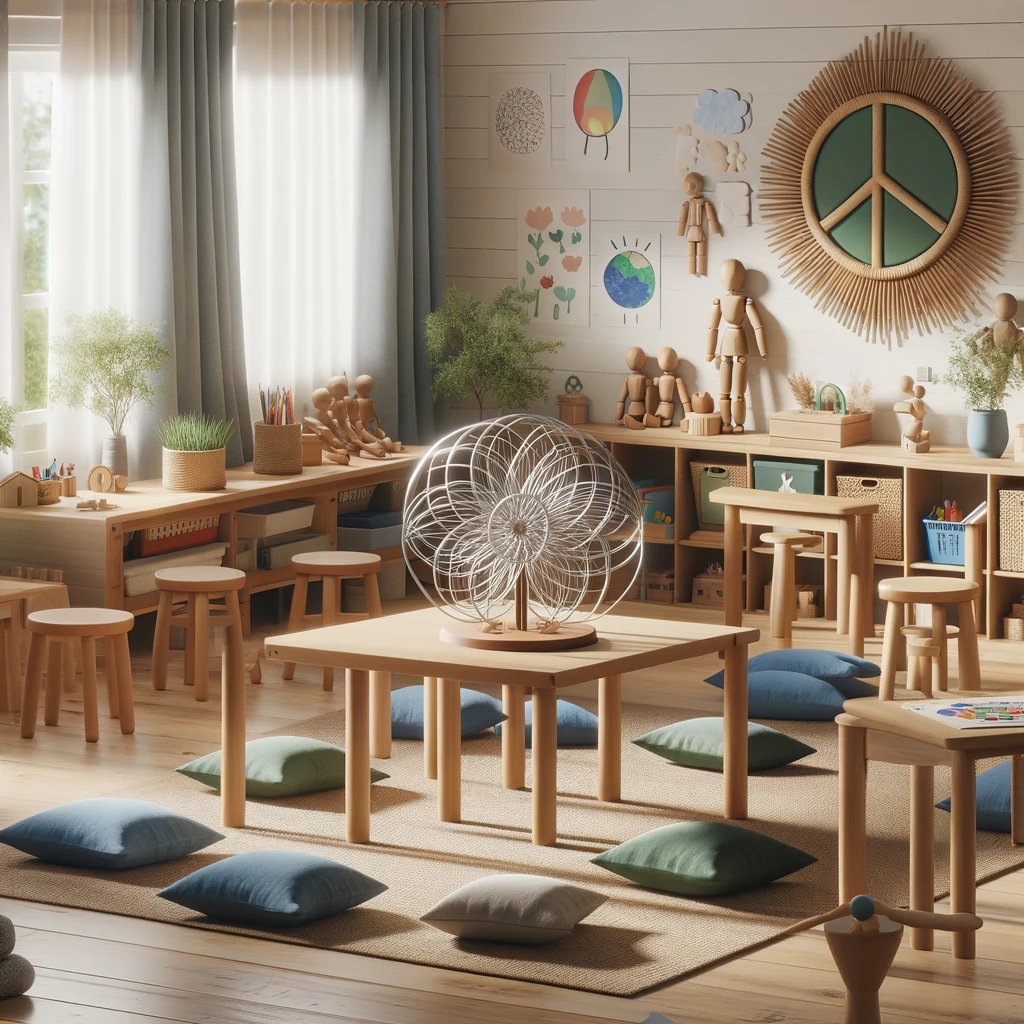Introduction to Montessori Peace Corner Dr. Maria Montessori believed her system would bring the world cause complete human regeneration. She stressed the need to have a broad perspective and sheer determination in order to bring world peace. As everything in the universe is interconnected, untiring peace efforts are required in all aspects of life to bring worldly peace.
The existing bonds between people, different communities and cultures, and the relationship between man and the environment must be directed to a peaceful path. Ignoring explicating or misusing any such connection at any level may lead to arguments, conflicts, civil upset, degradation of the environment and war.
The Montessori Peace Corner system helps the child realize that the actions of even a single person may greatly affect others and the environment. They are encouraged to explore the power and responsibilities of each person and maintain the integrity of all life.
The aim is to enable them to pursue, maintain, restore and enjoy peace all their lives. Pursuing peace is inherent in the Montessori system as a task requiring constant effort and the children practice the most appropriate time period of their lives.
Empowering Peacemakers: How the Montessori System Cultivates Peace and Responsibility in Children
The Montessori Peace Corner directs a balanced understanding of the universe to the child, which then naturally leads the child onto peaceful ways. The directress needs to inculcate peace in the environment and the children need to practice peace, and develop skills which result in peace. Through some formal classroom activities, the directress enables the children to learn the skills to be peacemakers.
She encourages them to understand each other’s needs, and adopt non-violent ways of reducing or resolving conflicts among each other. To encourage the children to be peacemakers the directress herself lives by the code of peace and consistently presents herself as a role model. She needs to be a firm believer of the cosmic fact herself that we are interconnected with other elements of the universe and our actions have consequences.
She herself should adopt a non-violent and non-aggressive attitude to resolve her conflicts with others and the children. For instance, if a teacher sometimes loses patience and shouts at children to make them listen to her, the children may repeat the same in order to make others listen to them.
She needs to frequently look within and reaffirm her commitment to peace. Children learn peaceful behavior more from the way the teacher speaks, responds to challenges, and looks at issues, than what she teaches. Obviously an unpeaceful teacher cannot teach peace, because her behavior contradicts with what she teaches.
Montessori Peace Corner Flower
Montessori Peace Corner Holistic peace can easily be related to three basic sources; inner peace, social peace and peace with nature.
1.Inner Peace
It refers to peace with oneself. It may include harmony in thoughts, joy, contentment, good health, absence of guilt and inner conflicts, sense of freedom, sense of gratitude, insight, emotional stability, positive feeling, etc.
2.Social Peace
Montessori Peace Corner It refers to peace with other human beings. It may include harmony at all levels of human relationships, absence of conflicts, efforts to reconcile and resolve conflicts, love, friendship, brotherhood, tolerance, cooperation, unity, acceptance of social values, obeying the laws, etc.
3.Peace with Nature
It refers to peace with the earth and mother nature. It may include conservation, recycling, saving endangered species of plants and animals, planting more trees, respecting all forms of life, love of nature, cutting out the use of elements for the environment, being green, etc.
The Montessori Peace Corner program revolves around The Peace Flower Model which embraces the three above basic sources. The Peace flower model provides a simple but concrete framework to Montessori teachers, which guides them to organize and structure their peace activities. Through its petals, the peace flower model represents four types of awareness which an individual needs to have in order to protect, restore and maintain peace.
In the Montessori Peace Corner system, a flower is used to represent the peace model because the flower symbolizes illumination, love, and beauty in many cultures. Secondly , flowers are delicate, fragile and sensitive which can be harmed easily, just like peace. Thirdly , flowers bloom and then wither but new flowers always replace the old ones which again represents the instability of life, and how a continuous effort is required to restore peace again whenever required.
In the classroom often a real or an artificial is used when the process of conflict resolution is going. Only the child holding the flower can speak while the other(s) listen to him. Then , the flower is passed and the other person can speak. The flower in hand reminds both the listener and the speaker of the need to treat each other with care and respect.
Most Montessori schools add flowers in the environment for sharing beauty and calm as a part of peace education. The symbol of the flower is present in most classrooms and is also included at designated peace areas inside the classroom or outdoor. Some schools also designate the garden or a part of it as a peace garden, where students and teachers regularly grow new flowers as an effort to glorify peace in the world.
Peace Petal No.1: Self-Awareness
Self-awareness refers to being aware of what someone is feeling, thinking, and how he/she is behaving. In other words, being self aware means being aware of one’s thoughts, feelings, actions with relevance to events taking place in the surroundings, and linking this awareness to the past experiences in the future. Furthermore , as children become aware of how their body, mind, emotions and spirit interrelate, they begin to have mastery over their bodies, minds and emotions…. Which results in manifestation of their true spirit.
Complete self awareness includes in the following areas;
Body
As children begin to become more aware of their bodies, its complex design, the symmetry and importance of various organic systems and the interaction between the brain and the organs, they do not just develop a sense of appreciation and gratitude, but also learn to have some control over their mental, emotional and spiritual states. Being aware of what actually is happening inside us, enables us to try to bring it under control. Thus, opportunities for learning about body parts, bones, joints, muscles, nerves, organs and organic systems (like circulatory system, respiratory system) should be provided to the children.
Thus, children are educated about the importance and functioning of their body parts, skeletal structure, organ system and internal system such as respiratory and digestive system, which also helps control their mental, physical and spiritual states.
Mind
Being aware of how the mind works enables children to improve their thought process, control their thoughts, replace their fake beliefs, concentrate on tasks, create and compose. Children who are more aware of how their mind works tend to be more productive and creative. Thus, areas like sensory awareness, thought process, imagination and creativity are given special importance.
Emotions
More awareness regarding their emotional states and how emotions may affect our bodies and minds, enables children to control negative emotional states and use emotions to work more constructively. Thus, children are provided with happiness, joy, calmness, anger, etc. They are also encouraged to express what they are feeling and to accept what others are feeling. Similarly the ability to respect someone’s emotional connections with other people, things and places is also an important area of concern.
Spirit
When the children start realizing the peace inside them, they begin to manifest it in their lives. And gradually they turn themselves into happy, cooperative, creative, sensitive and kind personalities. In this area, different rituals, celebrations, and traits like forgiveness, truthfulness and sincerity are specially to be focused.
A community cannot be peaceful unless the individuals that make it up are thoughtful, calm, loving, caring and peaceful. The level of peacefulness in a community or culture depends directly on the level of peacefulness of its members. The above discussion reveals why the first petal of the Peace Flower is about self-awareness and inner peace as it is the basis of the whole peace process.
Only when one is aware of one’s feelings, thoughts, actions and their consequences do they tend to change themselves. Ignorance to self-facts like they are causing conflict between others or they are damaging the environment, will not encourage any kind of change. Only self-awareness leads to a greater knowledge of others. For example, only a self-aware person can be sensitive towards what the other person would feel in a particular situation as he has experienced and realized it himself. Moreover, the state of being aware of one’s own needs brings awareness of what others might need. Thus, the more self-aware a person is, the more is the tendency to change for the better.
Self-awareness is a key and inbuilt feature of the Montessori approach. The child begins to experience it as he enters a Montessori school. Through his interaction with the prepared environment and observing the practices of the teachers, the child develops more and more awareness of his thoughts, emotions and actions along with self-confidence and independence.
Conclusion:
The Montessori Peace Program, anticipated through Dr. Maria Montessori, offers a transformative approach to training that intertwines peace with normal mastering. This application isn’t merely approximately teaching peace as a idea however immersing children in practices that foster an intrinsic appreciate for peace at each level—private, social, and environmental. Through the precise factors of the Montessori system, youngsters are advocated to explore their actions’ impact on others and the environment, cultivating a experience of responsibility and interconnectedness.
The Montessori Peace Corner introduction of the Peace Flower Model in Montessori classrooms serves as a tangible reminder of the peace method. This model no longer only symbolizes splendor and sensitivity however additionally represents the continued effort required to nurture and preserve peace. It’s a tool that allows youngsters analyze the important skills of negotiation, empathy, and appreciate, essential for his or her development as peacemakers.
